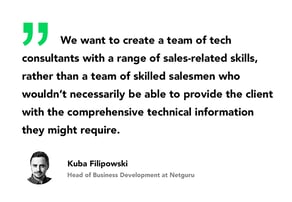How to Create a Buyer Persona in 2023: A Step-by-Step Guide

Key Takeaways
-
Understand buyer personas to create personalized experiences and target ideal customers.
-
Gather data from existing customers, market research, & sales/customer support teams for an accurate persona profile.
-
Regularly validate & update your persona. Use tools/templates for the quick creation of comprehensive profiles.
Understanding Buyer Personas
Think of buyer personas as your marketing compass, guiding your efforts to reach and connect with your ideal customers. To create buyer personas, focus on creating accurate and detailed profiles that can help you not only broaden your customer base but also foster customer loyalty through understanding customer personas.
Segmenting your marketing efforts allows for effective targeting of audience niches, enabling the delivery of personalized experiences that cater to their distinct needs and preferences.
The Role of Buyer Personas in Marketing
Crafting an effective marketing strategy and understanding customer needs require well-structured buyer personas. Imagine trying to hit a target with a bow and arrow while blindfolded. That’s what marketing without buyer personas is like. By pinpointing your target audience’s pain points, preferences, and goals, you can create marketing messages that hit the mark and resonate with your customers.
Depending on the target audience’s goals, a buyer persona could aim for objectives ranging from cost savings and productivity increases to growth promotion. Your marketing team can provide valuable insights and data from inbound marketing campaigns, customer surveys, and lead capture forms, giving you a better understanding of your target audience.
The Difference Between B2C and B2B Buyer Personas
While both B2C and B2B buyer personas serve the same purpose – guiding marketing efforts and customer understanding – there are key differences in their construction. B2C personas focus on individual customers, while B2B personas involve several decision-makers within an organization.
For example, in the SaaS industry, common B2B buyer personas include department heads and management teams. Creating accurate B2B buyer personas necessitates understanding the organization’s varying roles, decision-making processes, and each decision-maker’s unique challenges and objectives.
Gathering Data for Your Buyer Persona
Having grasped the significance of buyer personas, it’s appropriate to collate the necessary data for their creation. The process starts with analyzing your existing customers, conducting market research, and utilizing insights from your sales and customer support teams.
Each of these sources provides valuable information that can help you create a well-rounded and accurate buyer persona. Developing a detailed profile that accurately mirrors your target audience’s needs, preferences, and behaviors is possible when you amalgamate data from diverse sources.
Analyzing Existing Customers
Your existing customers are a treasure trove of information that can help you create accurate buyer personas. A better understanding of your target customer can be achieved by examining the shared traits and preferences of your existing customers, as well as the aspects of your product or service that resonated with them and those that didn’t satisfy them. This valuable insight can also be used to attract prospective customers with similar characteristics.
Take a look at your existing customer base and identify any patterns or trends. This could include factors such as demographic information, purchasing habits, and communication preferences. Tools like Facebook Audience Insights can provide valuable data on your target audience, including geography, demographics, and purchase behavior.
Conducting Market Research
Another crucial component of data gathering for your buyer persona is market research. By investigating industry trends and potential customer segments, you can gain a deeper understanding of your target market.
Methods for conducting market research include analyzing your competitors’ customer base, examining industry reports, and participating in trade shows or conferences. This research will help you identify potential opportunities for growth and expansion, as well as potential threats to your business.
Utilizing Sales and Customer Support Insights
Your sales and customer support teams interact with your customers daily, making them invaluable sources of information for your buyer persona. They can provide insights into customer behavior, pain points, and overall satisfaction with your product or service. In addition, your sales and marketing teams, along with your sales team, play a crucial role in utilizing this information to improve and promote your offerings.
Collaboration with your sales and customer support teams enables the identification of customer behavior patterns and trends and facilitates feedback collection on your product or service. This information will help you refine your buyer persona and better understand the needs and preferences of your target audience.
For example, your customer support team may notice that a significant number of customers are struggling with a specific feature of your product. This insight could be used to improve the product or create targeted marketing materials to address this common pain point.
Creating Your Buyer Persona: A Step-by-Step Process
With the requisite data collated, the creation of your buyer persona can commence. The process involves:
-
Defining demographics and psychographics
-
Identifying pain points and goals
-
Developing a detailed profile
-
Regularly validating and updating the persona with new data and insights.
Bear in mind that your own buyer persona ought to be a dynamic embodiment of your ideal customer. As your business and target audience evolve, so should your buyer persona. Regularly updating your persona ensures that it remains accurate and relevant, providing you with the most up-to-date insights for your marketing efforts.
Define Demographics and Psychographics
A comprehensive customer profile creation necessitates the definition of demographics and psychographics. Demographic information includes factors like age, gender, income, education level, and location, while psychographics encompasses spending habits, challenges, lifestyle, and goals.
By understanding both demographic and psychographic information, you can create customized marketing messages that resonate with each segment of your audience. This allows you to offer products or services that are attractive to specific customer groups and tailor your marketing efforts accordingly.
Identify Pain Points and Goals
To grasp customer motivations and needs, it’s vital to identify their challenges and objectives. Pain points are the challenges or frustrations that your customers face, while goals are the desired outcomes they hope to achieve by using your product or service.
By pinpointing pain points and goals, you can better understand what drives your customers and how your product or service can help them overcome their challenges or achieve their objectives. This information can be used to create targeted marketing materials and improve your overall product or service offering.
Develop a Detailed Profile
Once you’ve gathered the necessary data and identified pain points and goals, it’s time to develop a detailed profile for your buyer persona. This should include a name, an image, and a backstory that brings your persona to life.
A detailed profile not only helps you visualize your ideal customer but also serves as a reference point for your marketing and sales teams. By providing a clear and comprehensive picture of your target audience, a detailed buyer persona can guide the development of marketing materials, sales strategies, and product improvements.
Validate and Update Your Persona
Creating a buyer persona isn’t a one-off task. Regular validation and updating of your persona are crucial for maintaining its accuracy and relevance. As your business evolves and your target audience changes, your buyer persona should be updated to reflect these shifts.
By regularly reviewing and updating your buyer persona, you can:
-
Stay informed about changes in customer behavior, preferences, and needs
-
Adjust your marketing strategies accordingly
-
Continue to connect with your target audience in a meaningful and impactful way.
Customizing Your Buyer Persona for Different Marketing Channels
Having developed a well-crafted buyer persona, customizing it for various marketing channels becomes a vital step. This includes tailoring content and segmenting your audience for personalized marketing campaigns.
By customizing your buyer persona for different channels, you can create a more personalized and engaging experience for your customers. This not only leads to improved customer engagement but also helps you optimize your content strategy and increase sales.
Tailoring Content for Your Persona
Forming strong connections with your audience necessitates creating content that caters to the specific needs and preferences of your buyer persona. By understanding their pain points, goals, and motivations, you can develop content that speaks directly to them and offers solutions to their challenges.
For example, if your buyer persona is a busy working parent, you might create content that offers time-saving tips, easy meal ideas, or stress-reduction strategies. By tailoring your content to address the unique needs of your persona, you can create a more engaging and relevant experience that keeps your audience coming back for more.
Segmenting Your Audience for Personalized Marketing
Another key facet of tailoring your buyer persona for various marketing channels is audience segmentation. By dividing your audience into smaller segments based on:
-
demographic characteristics
-
geographic location
-
psychographic traits
-
behavioral patterns
You can deliver more personalized marketing campaigns and improve customer engagement.
Successful audience segmentation can lead to more targeted marketing campaigns that resonate with your customers and result in higher conversion rates. For example, you might segment customers based on their location and offer localized deals or promotions, or segment them by their purchase history to provide tailored product recommendations.
Tools and Templates for Building Buyer Personas
A list of tools and templates are provided below to aid in building your buyer personas efficiently and accurately, thereby streamlining the process:
-
MakeMyPersona: This online tool guides you through creating an ideal customer profile by answering a series of questions about your target audience.
-
Qualtrics Experience ID: This tool helps you build and analyze buyer personas using data from customer surveys, lead capture forms, and more.
-
Filestage’s Buyer Persona Template: This template provides sections for a tag cloud, archetype, and product adoption group, allowing you to create a comprehensive buyer persona.
-
Online Learning Platform Customer Persona Template: This template helps you understand user personas for online learning platforms and create content tailored to their learning preferences and goals.
-
Marketo’s Marketing Persona Cheat Sheet: This fill-in-the-blank map guides you through creating a consumer persona and includes instructions for creating a customer journey and buyer journey template.
These tools can save you time and ensure that your buyer personas are accurate, detailed, and effective.
Summary
In conclusion, creating accurate and detailed buyer personas is crucial for connecting with your target audience and developing marketing strategies that resonate with their needs and preferences. By following the step-by-step process outlined in this guide, gathering data from various sources, and customizing your personas for different marketing channels, you can create buyer personas that truly reflect your ideal customer and drive your marketing efforts to new heights. Now it’s time to put this knowledge into action and create your own buyer personas that will guide your marketing strategy and help your business grow.




















